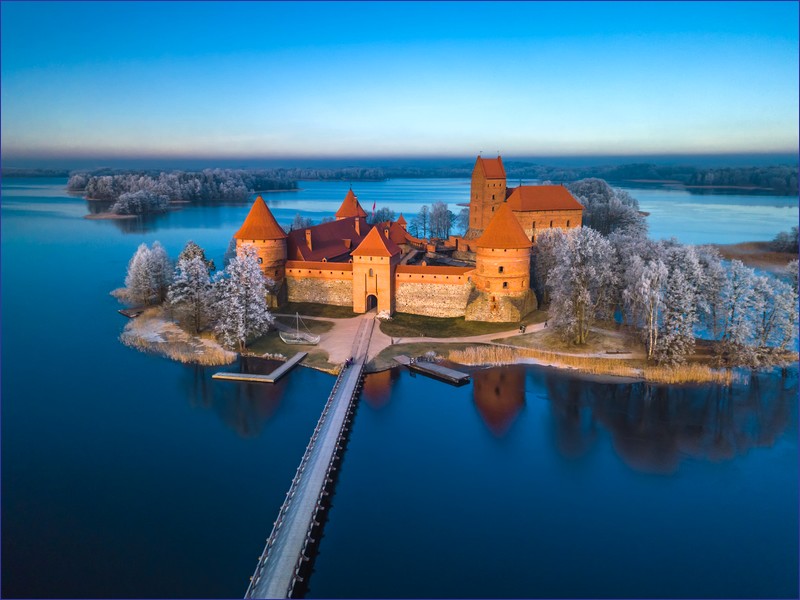Travel by train in Lithuania allows you to reach the country’s largest cities. Trains, apart from the Vilnius – Kaunas route, do not run often and are not cheap, but thanks to new investments, the comfort of traveling is improving. The most popular railway routes in Lithuania are Vilnius – Kaunas and Vilnius – Klaipėda. Trains do not reach the popular tourist destinations on the Curonian Spit, passengers must have to change to a bus in Klaipėda.
Last updated: 31.03.2025
Currently, the construction of the Rail Baltica railway line is underway.
Train travel in Lithuania – domestic trains
To the surprise of travelers, most of Lithuanian trains and stations make a very good impression. They are good maintained, and many trains have been refurbished in recent years. Only problem are toilets at railway stations – there are often Turkish toilets, but in trains the toilets are not very clean. Lithuanian Railways consistently replaces rolling stock.
In Lithuania there are no rail pass allowing to unlimited travel by train for several days, but from December 2023 you can buy one day ticket for a specific route. Since 2019, you can buy an Interrail ticket to Lithuania, but the price makes it unprofitable if you do not travel all day for three days. Perhaps it is good choice for young people.
bilietas.ltglink.lt – trip planner, timetable and online shop. Recently, purchasing tickets has been simplified, you can easily add a discount or buy an additional ticket for transporting a bicycle or dog or search international trains.
Important websites:
Traveling with bicycle
Traveling with pets
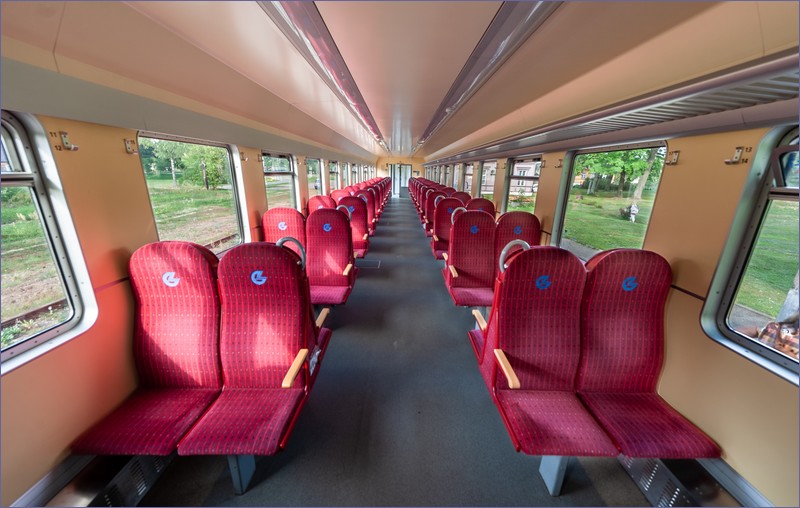
Tourist can travel by train from Vilnius to Trakai, known for world-famous castle complex revived from ruins, located on an island in Lake Galvė. Train station in Trakai is located 1,5 km from the lake.
There are regional trains from Vilnius to Turmantas, close to Lithuanian-Latvian border, from Kaunas to Siauliai and from Siauliai to Klaipeda. If you want to get to Palanga, you must get off from the train in Kretinge and change to the bus to Palanga. In the nearest future railway line to the Palanga will be build.
Trains from Kaunas run to Siauliai and Marijampole. There are regional trains from Siauliai to Panevezys and from Panevezys to Mazeikiai.
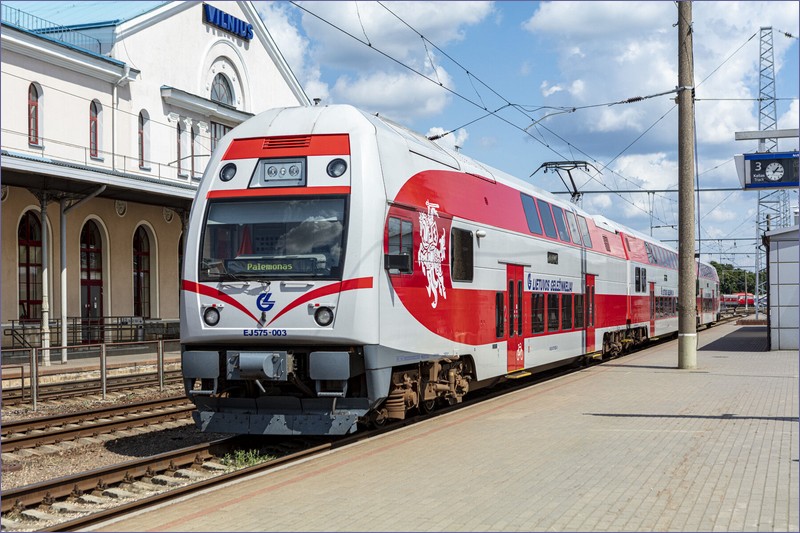
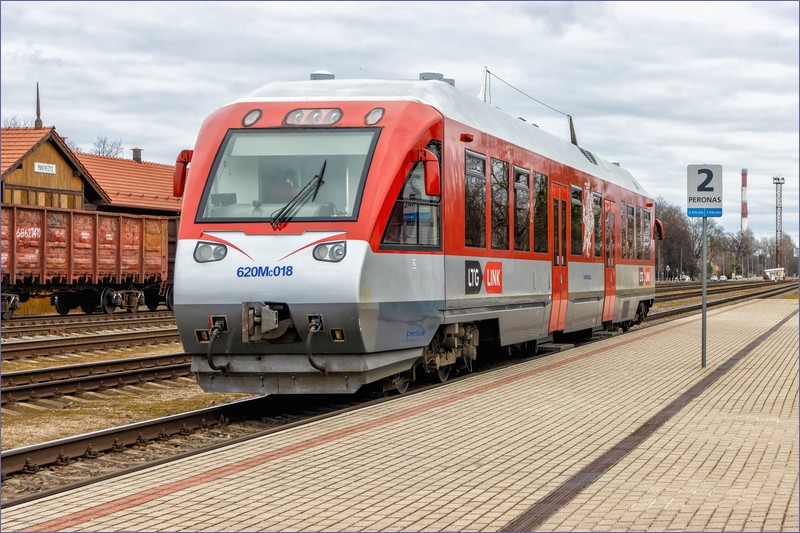
Train travel in Lithuania – international trains
Lithuania has a railway connection with all adjacent countries, but there are only a few international passenger trains.
Belarus
Direct trains from Vilnius to Minsk ran several times a day in each direction but were suspended due to the war in Ukraine.
Kaliningrad Oblast
There are no passenger trains from Kaliningrad to Lithuania. In 2018 the service from Klaipeda to Sovetsk was launched. The train ran for a very short time and was cancelled. Transit trains from Kaliningrad to Russia and Belarus run through Lithuania.
Latvia, Estonia
On 27 December 2023 will start direct train from Vilnius to Riga. Train will stops in Siauliai and Jelgava. Train will departs from Vilnius in the morning and from Riga to Vilnius in the afternoon.
There is a direct train from Vilnius to Valga where you can change train and continue your journey to Tartu and Tallinn. Estonian train from Valga to Tallinn will be wait on the same platform. There is no need to change trains in Riga. Train runs daily. Ticket for the entire journey from Vilnius to Tallinn costs 39 eur.
Tickets are not sold for the trips from Jelgava to Riga and from Riga to Jelgava.
Ticket from Vilnius to Riga costs 34 EUR. If you want to travel with bicycle, you need to pay supplement 10 EUR. Ticket for pets costs 5 EUR.
The trip time between Vilnius and Riga is approximately 4 hours. On the route Vilnius – Riga seat reservations is compulsory.
There are plans to reinstate Vilnius – Daugavpils train in the nearby future.
bilietas.ltglink.lt – timetable, prices and online shop
Poland
There is an only one train between Poland and Lithuania. International train Krakow – Vilnius in fact are two trains – Polish train from Krakow to Mockava operated by PKP Intercity and Lithuanian train from Mockava to Vilnius operated by LTG Link. You need to change trains at Mockava station. Polish and Lithuanian train stop at the same platform so there is no problem.
In Lithuanian train from Mockava to Vilnius seat reservation is compulsory.
Train from Krakow to Mockava is comprised of modern, comfortable and air-conditioned carriages with compartments and open coaches. From Mockava you will continue your journey in LTG Link’s diesel multiple unit PESA630MiL or PESA730M made in Poland. It’s a modern train equipped with air-conditioning and vacuum toilet, seats are arranged 2+2 and you can buy snacks and drinks.
Ticket prices:
Vilnius – Warsaw – 25 EUR
Vilnius – Krakow – 30 EUR
Kaunas – Warsaw – 20 EUR
Kaunas – Krakow – 25 EUR
Kaunas – Suwalki – 11 EUR
bilietas.ltglink.lt – timetable, prices and online shop (LTG Link)
intercity.pl – online shop (PKP Intercity)
Summer weekend train from Bialystok to Kaunas was ceased.
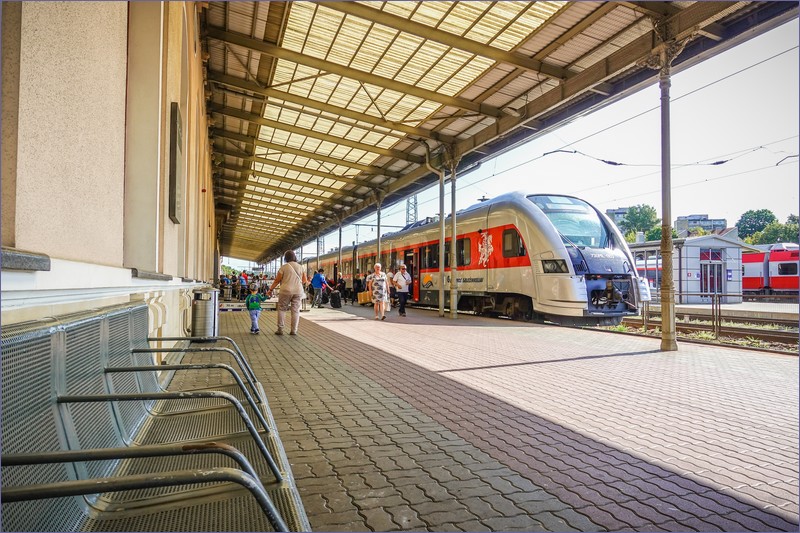
Narrow gauge railway Anyksciai – Rubikiai
A little-known tourist attraction in Lithuania is the narrow-gauge railway from Panevezys to Onikště, built in 1899, and regular heritage train services were officially launched on May 13, 2001. From Anyksciai the section of the railway line leads to Rubikiai. The preserved section is just a small part of the original line that once ran all the way to Utena, connecting two of Lithuania’s most famous breweries.
The narrow-gauge railway runs regularly on Saturdays and Sundays from May to October on the Anyksciai – Rubikiai route. The journey takes about 50 minutes, then in Rubikiai passengers have two hours off. Then the train starts its return journey.
Tourist groups can charter a train, and for an additional fee the organizers will arrange a “train robbery”, an orchestra and other attractions. The narrow gauge railway has a poor marketing, but it could attract many tourists.
More information: siaurukas. eu
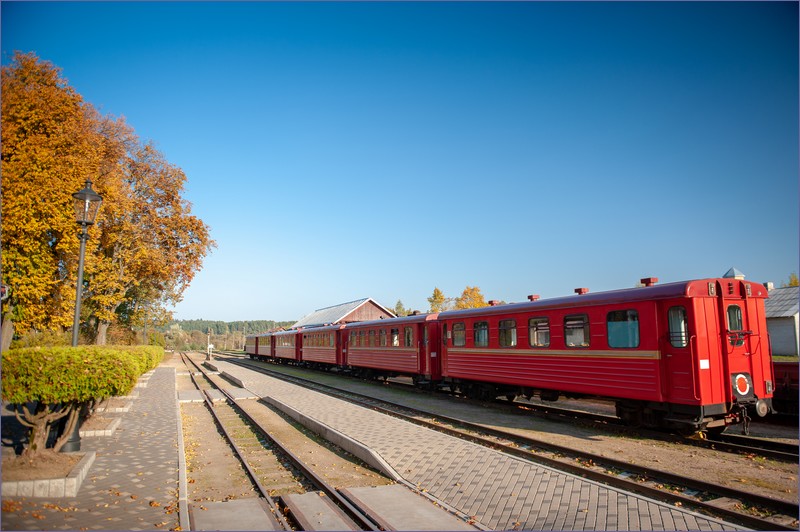
Railway museum in Vilnius
A museum located in the building of the Vilnius railway station with an outdoor exhibition of rolling stock at the extension of platform 1. A small museum, inexpensive admission tickets, the exhibition of rolling stock receives good reviews, while the indoor exhibition will be of interest mainly to railway enthusiasts.
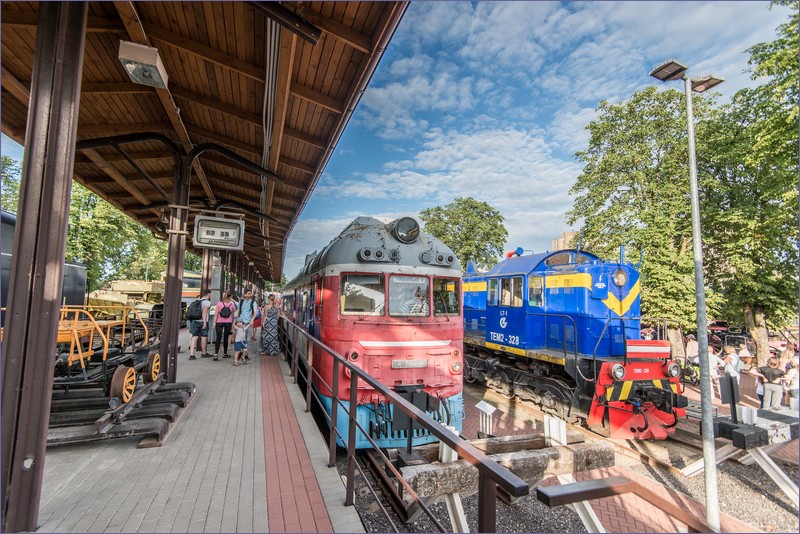
What to see
Lithuania is a small country, but it has a lot to offer, including picturesque forests and lakes that have yet to experience an influx of tourists. Here’s a short guide to the country’s most important attractions. However, keep in mind that not all of them are accessible by train.
Vilnius – the capital of Lithuania and a must-visit destination. It boasts a well-preserved Old Town with numerous historical landmarks. Most famous tourist attractions include Vilnius, the capital of Lithuania, is full of historical landmarks, cultural sites, and unique districts. Here are the top tourist attractions you shouldn’t miss:
Pilies Street – a charming street with shops, cafes, and historical buildings, Didžioji Street – lined with grand architecture and cultural sites, Gediminas’ Tower which offers panoramic views of the city (Old Town). Neoclassical Cathedral Basilica of St. Stanislaus is the main Catholic church in Lithuania, worth visit is also the St. Anne’s Church and Bernardine Church.
Very popular among tourists is Užupis – The “Independent Republic” – a bohemian district which features street art, quirky cafes, and an alternative arts scene.
Families with children enjoy the Museum of Energy and Technology, while the Lithuanian Bank’s Money Museum gets great reviews for its rich collection of banknotes and coins from around the world.

Kaunas – a second-largest city in the Lithuania. A popular day-trip destination from Poland due to its proximity to the border. However, opinions about Kaunas are mixed. Most important landmarks: St. Peter and Paul Basilica, Town Hall, remnants of the fortress, and two funicular railways. If you visit Kaunas, consider a trip to the Pažaislis Monastery.
There are direct trains from Vilnius to Kaunas, train from Mockava to Vilnius stops at Kaunas station.
Trakai – a beautifully reconstructed castle, picturesquely located by a lake. The town also features traditional Karaim houses. Accessible by train from Vilnius, although connections are limited outside the tourist season.
Klaipeda – Lithuania’s third-largest city and its only seaport. It serves as a gateway to the Curonian Spit. Old Town features half-timbered buildings, cobblestone streets and unique sculptures. There are remnants of a 13th-century Teutonic castle. Popular tourist attractions is Lithuanian Sea Museum & Dolphinarium. You can see Strong German and Scandinavian influences in architecture and traditions.
Palanga – a popular seaside resort on the Baltic Sea, not just among Lithuanians. Except from sandy beaches you can visit The Amber Museum in the Tyszkiewicz Palace, The Resort Museum, The Botanical Park. The most important historical site is the Church of the Assumption of the Blessed Virgin Mary (1897-1907). You’ll also find wooden houses and old cottages in Palanga and its surroundings.
There are buses from Kretinga station (on the Vilnius – Klaipėda railway line). A rail link to the resort is planned.
Curonian Spit – a great destination for cycling, featuring small villages, wooden houses, sand dunes, and rolling hills. No railway access—you must travel by bike or car from Klaipėda.
Dzūkija National Park – a tranquil area with pine forests, hiking trails, and traditional wooden villages. The perfect escape from urban life. Start your hike near Marcinkonys station, reachable by local trains from Vilnius.
Aukštaitija National Park – Lithuania’s oldest national park, known as the “Land of a Thousand Lakes”.
Highlights: wooden church in Palūšė, Beekeeping Museum in Stripeikiai, Ladakalnis Hill, a former sacrificial site and scenic viewpoint
Train access: Ignalina station, served by Vilnius – Turmantas trains.
Kernavė – a UNESCO-listed site, often called “Lithuania’s Troy”.
This former Lithuanian capital features: a cultural reserve, the complex of hillforts, archaeological sites, a reconstructed ancient settlement. Great views of the Neris River meanders from the hillforts.
No train service—you’ll need to travel by car or bus.
Cold War Museum in Plokščiai – an unique museum inside a former military base with ballistic missile silos. Visitors can explore the bunker and missile launch facility. Nearby: Scenic lakes, hiking trails, and a national park.
Closest train station: Plungė, several kilometers away.
Rumšiškės Open-Air Museum – Kithuania’s largest open-air museum (195 hectares), one of the largest in Europe. Features historical buildings from various regions of Lithuania, dating back to the 18th-20th centuries. The main attraction is the recreated old town square.
Limited access outside peak season, as most buildings remain closed.
Train access: Pravieniškės station (4.5 km away), but buses or minibuses from Kaunas are more convenient.
Hill of Crosses – one of Lithuania’s most famous landmarks. Located a few kilometers from Šiauliai, this pilgrimage site holds over 150,000 crosses. Mixed reviews: Some find it impressive, others consider it overhyped.
Visaginas (optional) – a Soviet-era planned city built in 1975 to house workers from the Ignalina Nuclear Power Plant. Once a model modern city, featuring broad streets, schools, kindergartens, and shops. Since the closure of the power plant in 2009, the town has declined, with many young people leaving. Parts of the HBO series “Chernobyl” were filmed at the decommissioned nuclear plant.
Trains Vilnius – Turmantas stop here.
Kėdainiai (optional stop) – one of Lithuania’s prettiest small towns, though neglected. Once a residence of Polish nobility. You can see historic market square and old streets, several churches, including the wooden Church of St. Joseph Sadly, the Radvila Palace was destroyed in 1944.
Train station is far from the center.
Related articles:
Narrow gauge railways in Lithuania
Funicular railways in Lithuania
Railways in Europe by country
